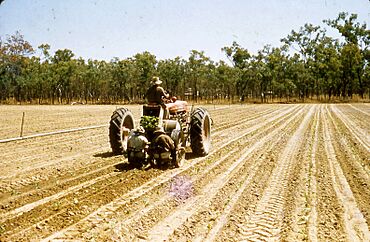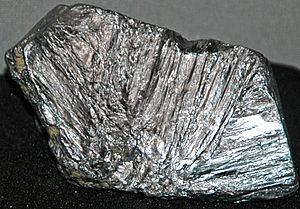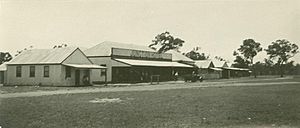Dimbulah, Queensland facts for kids
Quick facts for kids DimbulahQueensland |
|||||||||||||||
|---|---|---|---|---|---|---|---|---|---|---|---|---|---|---|---|

Farming at Dumbula, circa 1958
|
|||||||||||||||
| Population | 975 (2021 census) | ||||||||||||||
| • Density | 1.3855/km2 (3.588/sq mi) | ||||||||||||||
| Established | 1876 | ||||||||||||||
| Postcode(s) | 4872 | ||||||||||||||
| Elevation | 407 m (1,335 ft) | ||||||||||||||
| Area | 703.7 km2 (271.7 sq mi) | ||||||||||||||
| Time zone | AEST (UTC+10:00) | ||||||||||||||
| Location |
|
||||||||||||||
| LGA(s) | Shire of Mareeba | ||||||||||||||
| State electorate(s) |
|
||||||||||||||
| Federal Division(s) | Kennedy | ||||||||||||||
|
|||||||||||||||
|
|||||||||||||||
Dimbulah is a country town in Far North Queensland, Australia. It is about 114 kilometres (71 miles) by road from Cairns. Dimbulah is located on the Atherton Tableland. It is part of the Shire of Mareeba local government area. In 2021, Dimbulah had a population of 975 people.
Contents
Exploring Dimbulah's Location
Dimbulah is about 100 kilometres (62 miles) south-west of Cairns. The town started near the Walsh River. It was a place for trains to stop and get water. These trains were used for the Hodgkinson goldfields and the old mining town of Wolfram. You can still see old mining ruins there today.
The Tablelands railway line goes through Dimbulah. The main train station is Dimbulah railway station. Other old stations along the line are now closed.
Water and Farming in Dimbulah
Dimbulah became a farming area because water was available. The Walsh River helped, but it wasn't always enough. Later, the Tinaroo Dam and the Mareeba-Dimbulah irrigation system were built. This gave farmers a lot more water. It helped the tobacco industry grow a lot.
The soil in Dimbulah is great for growing tobacco. It's sandy and helps grow a lighter type of tobacco leaf. The main plants around Dimbulah are eucalyptus trees and grasses like kangaroo grass.
Dimbulah's Weather
People in Dimbulah enjoy a tropical climate. This means they have hot, wet summers. Their winters are dry and mild.
A Look at Dimbulah's Past
The town of Dimbulah began in 1876. It was set up to support the Tyrconnell Gold Mine. This mine was one of the richest in the Hodgkinson Gold Fields. The name "Dimbulah" might come from an Indigenous Australian word. It means "long waterhole," which describes the nearby Walsh River. The Dimboola Post Office opened around 1900 and changed its name to Dimbulah in 1904.
Indigenous History
The Djankun and Kuku Djungan tribes originally lived in the Dimbulah area. In the 1920s, the Queensland Government took many of their children from their families. This caused the tribes to be separated.
Italian Influence and Tobacco Farming
In the early 1900s, many people from Italy moved to Dimbulah. In 1928, tobacco farming started. It quickly became the biggest industry in the area. At its best, 800 farmers grew tobacco here. They produced over 8,000 tonnes (about 60% of Australia's total tobacco). "The Way Back In" is a project that shares stories about Italian communities in Dimbulah and other nearby towns.
Schools in Dimbulah's History
- Boonmoo Provisional School opened around 1910 but closed a few years later.
- Dimbulah State School opened in 1914. In 1965, it added a secondary department for older students. The school celebrated its 100th birthday in 2014.
- St Anthony's Catholic School opened in 1966. It was started by the Sisters of St Joseph of the Sacred Heart.
Who Lives in Dimbulah?
In 2011, Dimbulah had 1,414 people. By 2016, the population was 1,050. In the most recent count in 2021, Dimbulah had 975 residents.
Important Places in Dimbulah
Dimbulah has some places listed on the Queensland Heritage Register. These are important historical sites. They include:
- The La Société Française des Métaux Rares treatment plant on Main Street, Wolfram.
- The Thermo Electric Ore Reduction Corporation Mill on Wolfram Road, Wolfram.
Dimbulah's Economy and Jobs
Tobacco used to be the main crop in Dimbulah. But government rules changed, and tobacco farming stopped. Now, farmers are trying new crops. These include tea trees, mangoes, sugar cane, coffee, and many fruits and vegetables.
Farming offers many jobs in Dimbulah. Many travellers, like backpackers, come to work on farms. This is especially true during the busy mango harvest from November to January.
Learning in Dimbulah
Dimbulah has schools for younger students:
- Dimbulah State School is a government school for students from Prep (kindergarten) to Year 10. It is located on Kennedy Street. In 2018, it had 150 students.
- St Anthony's School is a Catholic primary school for students from Prep to Year 6. It is on Hyde Street. In 2018, it had 37 students.
There are no schools in Dimbulah that go up to Year 12. Older students might go to Mareeba State High School in Mareeba. Some students also use distance education (learning from home) or go to boarding schools.
Dimbulah also has:
- Dimbulah Limited Hours Child Care (for ages 15 months to 5 years)
- Dimbulah Kindergarten (for ages 3 to 5 years)
Things to Do and See in Dimbulah
Dimbulah has a public library at the Shire Hall. The Queensland Country Women's Association (QCWA) also has a hall here. St Anthony's Catholic Church is on Raleigh Street.
If you visit, you can stay at the town's caravan park or the Junction Hotel.
In 2021, Dimbulah had many shops and services, including:
- A bank with an ATM
- An Australia Post office
- A chemist and a health and beauty store
- The Camp 64 Museum Cafe
- A bakery and a butcher
- A hardware store
- A mini mart and a convenience store
- Two petrol stations
There are many community groups in Dimbulah, like the Community Centre, Men's Shed, and Lions Club.
Dimbulah also has many sports clubs. You can find swimming (with an Olympic-sized pool), tennis, horse riding, lawn bowls, Rhee Taekwon-Do, and soccer/football.
The town has a Police station, a health clinic, and good internet and mobile phone service.
Fun Events in Dimbulah
Dimbulah has some exciting yearly events:
- The annual Lion's Festival, held in May.
- The Great Wheelbarrow Race, also held in May.
St Anthony's Catholic Church celebrates the Feast Day of St Anthony of Padua every year. This happens on the third Sunday of June. It includes a special church service, a parade, a barbeque, and a pesca (a fun lucky dip game).
Getting Around Dimbulah
You can get to Dimbulah from Cairns by bus, but it's not very frequent. The bus stops in Mareeba, which is about 45 kilometres (28 miles) from Dimbulah. The Savannahlander tourist train also stops in Dimbulah, but it doesn't run all year.
Famous People from Dimbulah
- The Hon. Keith De Lacy AM, who used to be the Treasurer of Queensland.
- Chris Sheppard, a former rugby league player.
- William Yang, a well-known photographer and actor.





